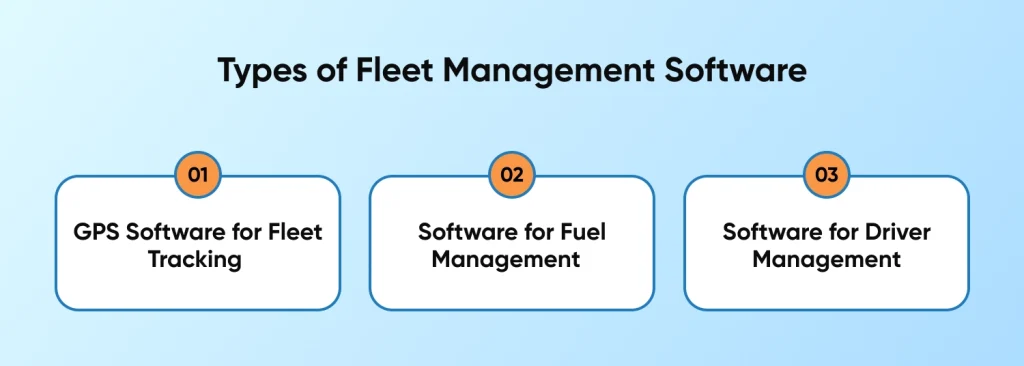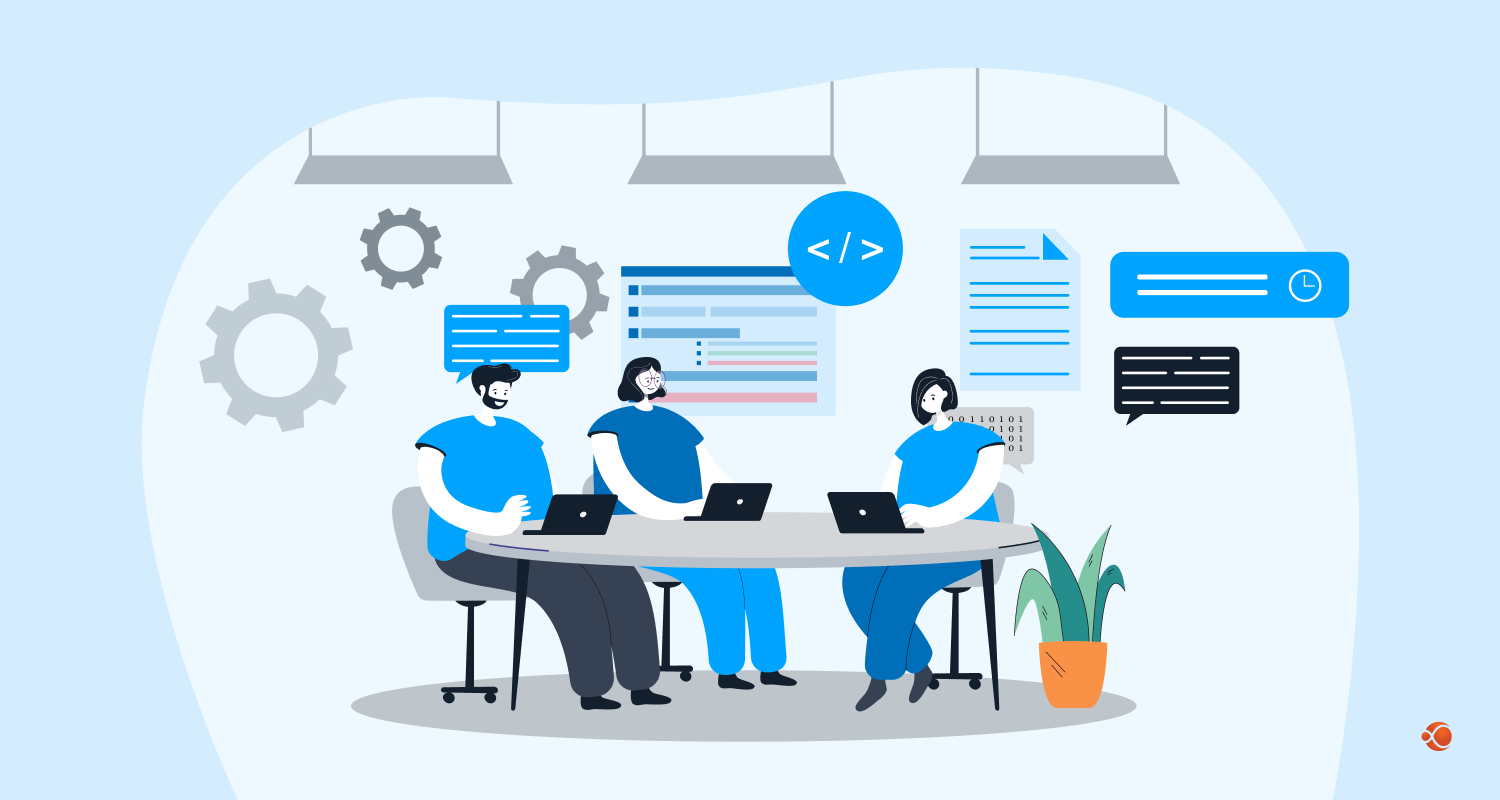Fleet management is one of the biggest challenges facing most transportation organizations. To stay relevant, traditional fleet management techniques need support as the logistics industry changes. The shifting logistical scenarios make it difficult for traditional fleet management strategies to stay up to date, which leads to inefficiencies, high operating costs, and a decline in competitiveness.
The global fleet management software market is predicted by Fortune Business Insights to grow at a compound annual growth rate (CAGR) of 18.3% over the next five years, culminating in a valuation of $67.38 billion. Companies are finding themselves in a situation where they are unable to fulfill the increasing demand for advanced lean operations combined with superior customer service; nevertheless, they are managing to do so at an increased expense.
This blog will walk you through the key components of developing fleet management software, fleet management types, and features.
What is Fleet Management Software?
This cloud-based solution ensures optimal control over commercial vehicles from a single dashboard, making it appropriate for travel, logistics, and supply chain organizations.
With the use of GPS and data analytics, custom fleet management software produces insightful reports that help managers cut costs and save time, labor, and resources. To maximize vehicle maintenance, driver safety, route planning, compliance, fuel consumption, and other factors, the vehicle management component assists in the real-time monitoring of assets and vehicles. It guarantees that their commercial cars are used to their full potential from a single dashboard.
It makes sense for fleet management businesses that manage and maintain commercial vehicles to invest in fleet management software development to ensure optimal asset performance.
Benefits of Developing Custom Fleet Management Software

Fleet management software that is customized to meet your company’s needs can provide you with several advantages. Custom software is distinct and made to meet your specific needs, which helps to maximize the operation. The major benefits of creating a custom fleet management software solution are as follows:
1. Increased Productivity and Efficiency
Boost productivity and efficiency by having the software adhere to your logistic app development process, automating common tasks, streamlining work processes, and increasing overall productivity. By lowering manual mistake rates, custom solutions help you save time and money.
2. Better Cost Management
With the custom fleet management software, you may schedule maintenance tasks on time, optimize your routes, and keep an eye on your fuel usage. Therefore, your bottom line would have benefited greatly from these savings.
3. Flexibility and Scalability
Because of its flexible design, the custom fleet management software may expand to meet your growing business’s fleet management needs. This degree of adaptability guarantees that the program expands along with your business.
4. Analytics and Data in Real Time
Custom solutions provide real-time data and analytics that aid in understanding driver behavior, fleet performance, and operational efficiency. This method of decision-making enables more strategic and effective planning.
5. Enhanced Security
You have more control over security features when you use custom software. This implies that you can maintain compliance with industry standards and have robust security built in for your critical data.

Essential Fleet Management Software Features for Top-tier Logistics
To satisfy the various fleet operating needs, effective fleet management software development must include the following essential elements. The following features are essential for fleet management software to be successful.
Real-Time GPS tracking
GPS tracking is a must for fleet management software. For companies to plan routes and understand the location of the drivers or the vehicles, GPS tracking helps to guarantee safety.
Management of Vehicle Maintenance
For a fleet to remain functioning, routine maintenance is essential. Features for maintenance management include tracking each vehicle’s health, scheduling routine servicing, and sending out alerts for impending maintenance. This proactive strategy prolongs the fleet’s life and decreases downtime.
Monitoring of Driver Behaviour
The observation of driver behavior is one of the most crucial factors in ensuring efficiency and safety. You can recognize risk areas by looking for features like idling, hard braking, and excessive speeding. This kind of data improves general driving standards and enables customized instruction delivery.
Route Enhancement
Efficient route optimization software helps in effective route planning that reduces fuel costs and saves time. To determine the optimal routes, it examines traffic, delivery timetables, and road closures. This guarantees on-time delivery, which raises client satisfaction.
Combining with Different Systems
Fleet management software needs to interface with other platforms, like as CRM and ERP, to function properly. This makes it possible to promote improved departmental cooperation, data exchange, and communication, all of which contribute to increased efficiency.
Alerts and Notifications in Real Time
Fleet managers need to be updated in real-time on any events, such as unapproved use, delays, or vehicle breakdowns. Decisions to tackle issues can be made quickly thanks to real-time information.
Thorough Reporting and Analytics
One of the main themes is data-driven decision-making. Comprehensive reporting and analytics offer perceptions of the efficiency, cost, and performance of the fleet. It offers crucial data for long-term planning and ongoing development.
User-friendly UI
The software is guaranteed to be simple to use and navigate because of its user-friendly interface. As a result, managers and drivers will find it easier to adopt and use the program more effectively.
You may create fleet management software that satisfies intricate fleet operation requirements by implementing these essential elements. Collaborating with CMARIX, a logistics app development company, guarantees the proficient integration of these capabilities.
Types of Fleet Management Software

Let us take you through the different kinds of fleet management software that are available for different types of organizations before you think about developing your own.
GPS Software for Fleet Tracking
The creation of fleet monitoring software is to manage, track, and locate your cars. Interactive maps are integrated for effective resource management and real-time fleet position visibility. Fleet managers can use this information to plan routes, track vehicle movements, and make decisions in real-time using an advanced GPS tracking facility.
GPS tracking software also saves historical data, providing information about the positions of vehicles and the average amount of time spent at each stop. The ability to create virtual boundaries using geofencing further enables the setting up of alerts that are activated when vehicles enter or leave specified locations.
Software for Fuel Management
It is possible to get precise reports on driving performance and fuel consumption trends using a tailored fuel management system. With the help of a centralized dashboard, drivers can receive automated notifications for modifying their fuel-inefficient driving habits, and they can also receive prizes for driving safely and efficiently.
Software for Driver Management
The main goals of this program are to maximize driver performance and guarantee regulatory compliance. You can always check the top fleet management apps like Fleetio, Samsara, and Onfleet to understand the features and types of fleet management.
Steps to Follow in Fleet Management Software Development
The process of developing fleet management software is complex, and multidimensional, and requires careful attention at different stages. Whether it’s ROI, easy-to-adopt MVPs, or crucial features, make sure the entire development process satisfies the organization’s primary needs.
Step 1: Identify the Needs and Goals
Clearly define your objectives for the creation of the fleet management application. Determine the precise problems or goals you plan to solve as well as the necessary features and functions needed to achieve these goals. Consult prospective users, such as fleet managers, drivers, and maintenance teams, to learn about their requirements and preferences.
Step 2: Pre-Development
In the construction of a fleet management system, this step is essential. To fully comprehend the development process roadmap, extensive planning and research are carried out at this point. To attain the greatest results entails defining the criteria and determining which technologies are most appropriate.
The following crucial tasks are usually included in the discovery phase:
Market Analysis
Look at the current market for fleet management software to find potential and gaps. Examine rival products to determine what characteristics they provide and how you can set yours apart.
Technical Viability
The group evaluates the technical viability of the project, taking into account the choice of the fleet management technology stack, the scalability of the program, and the integration of several systems and data sources, including telematics and GPS.
Estimating the Budget and Timeline
The project timeline and preliminary budget are projected at this point. This guarantees that the project stays under budget and is finished on schedule, as well as helps set reasonable expectations.
For the creation of a fleet management system, a strong foundation must be laid during the pre-development stage. Once your goals are clear, work with an experienced business for enterprise application development services to create reliable software, that fits user expectations, targets particular pain spots, and has a clear path to development success.
Step 3: UI/UX
You should design wireframes and prototypes of the software’s UI/UX after you have a clear knowledge of its special features and target user base. It guarantees that the software works efficiently and is aesthetically pleasing and easy for fleet managers to use.
Step 4: Creating the MVP
While creating MVP we include the basic features and get ready with the initial software functions to test and improvise further as required. A well-known outsourcing app development hired can give the best result of the MVP before deployment.
Step 5: QA Testing
Test the software thoroughly for performance, security, and usefulness. Perform user acceptability testing and unit integration testing to make sure the program satisfies the specified requirements.
Step 6: Implementation
The software is formally launched during the deployment phase. Install the fleet management software on cloud or server platforms. Assemble the infrastructure required to manage the anticipated volume of users.
Step 7: Ongoing Support and Improvement
Hire a dedicated development team to guarantee that users can operate the software efficiently, and provide them with effective training and assistance. Provide user guides and make assistance available via customer service channels.
Choose CMARIX for the Development of Custom Fleet Management Software
The development of fleet management software is essential to solving the problems faced by fleet operators. Streamlining processes, improving safety, and optimizing costs are vital elements in today’s logistics industry. An intricate, varied industry can be made more effective, profitable, and efficient by integrating the appropriate software.
CMARIX is a leading Logistics Software Development Company that specializes in developing unique fleet management software solutions. CMARIX, often named one of the Best Custom Software Development Companies, leverages cutting-edge technology to propel corporate growth. Let’s connect and help you grow in the logistics industry.
Frequently Asked Questions
What Technologies Are Commonly Used in Fleet Management Software Development?
Advanced fleet management technologies to implement in business are AI/ML, telematics, Blockchain, IoT, Augmented reality, and fuel management systems.
Who Can Benefit from Fleet Management Software?
Any organization that caters to logistics or vehicle fleets can benefit from this software. Companies can manage and monitor drivers’ performance, and location and also maintain finances.
How Long Does It Take to Develop Fleet Management Software?
Developing a custom fleet management software takes normally 1- 3 months but if the software has complex features and functions to add, it may take up to 2 years.
How Much Does It Cost to Develop Fleet Management Software?
With the number of features and functions needed in the fleet software, the cost of fleet management software differs. It typically falls under a range of $25000 to $55000 based on several variables, such as the cooperation model used, feature complexity and quantity, etc.


![Fleet Management Software Development: Benefits, Features and Types [2025]](https://blog.cdn.cmarix.com/blog/wp-content/themes/cmarixinternal/public/images/no-image.png)




